Find more information in the General Comments section of the assessment
Find more information in the Rating Validity tab of the assessment
- See More
- See More
- See More
- See More
- Good
- Adequate
- Marginal
- Weak
- Poor
 Passenger
Passenger
 Driver
Driver
 Rear Passenger
Rear Passenger
 Driver
Driver
 Car
Car
 Pole
Pole
 Rear Seat
Rear Seat
 Front Seat
Front Seat
- Good
- Adequate
- Marginal
- Weak
- Poor


Passenger
outboard
center
Fitted to the vehicle as standard
Not fitted to the test vehicle but available as option
Not Available
-
Infants up to 13 kg
-
Infants and toddlers up to 18 kg
-
Toddlers from 9 to 18 kg
-
Toddlers over 18 kg
Easy
Difficult
Safety critical
Not allowed
| Seat Position | ||||
|---|---|---|---|---|
| Front | 2nd row | |||
| Passenger | Left | center | Right | |
| Maxi Cosi Cabriofix (Belt) | ||||
| Britax Römer King Plus (Belt) | ||||
| Britax Römer Duo Plus (ISOFIX) | ||||
| Britax Römer KidFix (Belt) | ||||
| Maxi Cosi Cabriofix & EasyFix (Belt) | ||||
| Maxi Cosi Cabriofix & EasyFix (ISOFIX) | ||||
| BeSafe iZi Kid X3 ISOfix (ISOFIX) | ||||
| Maxi Cosi Pearl & Familyfix (ISOFIX) | ||||
| Britax Römer KidFix (ISOFIX) | ||||
Easy
Difficult
Safety critical
Not allowed
The Mégane scored full points for its protection of both the 1½ year dummy and the 3 year dummy in the full scale crash tests. Both were seated in rearward-facing restraints. In the side barrier test, both dummies were properly contained within the protective shells of their restraints, minimising the risk of contact with parts of the vehicle interior. The front passenger airbag can be disabled to allow a rearward-facing child restraint to be used in that seating position. Clear information is provided to the driver about the status of the airbag and the system was rewarded. All of the restraint types for which the Mégane is designed could be correctly installed and accommodated in the car.
- Good
- Adequate
- Marginal
- Weak
- Poor

Head Impact 13.8 Pts
Pelvis Impact 6.0 Pts
Leg Impact 6.0 Pts
The bumper scored maximum points for its protection of pedestrians' legs, with good results at all test points. Likewise, the Mégane provided good protection to the pelvic region of a struck pedestrian. The protection provided by the bonnet to the head of a struck pedestrian was predominantly good or adequate, with poor results recorded only on the stiff windscreen pillars.
- Good
- Adequate
- Marginal
- Weak
- Poor
| System Name | Traffic Sign Recognition |
| Speed Limit Information Function | Camera based |
| Warning Function | System advised |
| Speed Limitation Function | System advised |
| System Name | ESP | |
| Performance | ||
| Vehicle Yaw Rate @ COS + 1.00 s | 2.6% | meets ECE requirements |
| Vehicle Yaw Rate @ COS + 1.75 s | 2.2% | meets ECE requirements |
| Lateral Displacement @ BOS + 1.07 s | 3.3 m | meets ECE requirements |
| Applies To | All seats | ||
| Warning | Driver Seat | Front Passenger(s) | Rear Passenger(s) |
| Visual | |||
| Audible | |||
|
|||
| System Name | Lane Departure Warning |
| Type | Lane Departure Warning |
| Operational From | 70 km/h |
| Warning | Audible & Visual |
| Performance | |
|
LDW Confirmation Test
|
Pass |
Electronic stability control is standard equipment on the Mégane, together with a seatbelt reminder that protects the front and rear seats. Autonomous emergency braking is available as an option but is not expected to be sold in sufficient numbers to qualify for assessment by Euro NCAP. A speed assistance system is an option that is expected to be broadly fitted. It uses an onboard camera to determine the speed limit at any point. This information is provided to the driver who can choose to let the system limit the car's speed as appropriate. A lane departure warning system is also available as an option on the Mégane and was rewarded in this assessment.
- Specifications
- Safety Equipment
- Videos
- Rating Validity
Specifications
Tested Model Renault Mégane 1.5dCi, LHD
Body Type - 5 door hatchback
Year Of Publication 2015
Kerb Weight 1318kg
VIN From Which Rating Applies - all Méganes, including Mégane Sedan
Class Small Family Car
Safety Equipment
Note: Other equipment may be available on the vehicle but was not considered in the test year.
Fitted to the vehicle as standard
Fitted to the vehicle as option
Not fitted to the test vehicle but available as option
Not Available
Not Applicable
Videos
Rating Validity








Find more information in the General Comments section of the assessment
 Share
Share
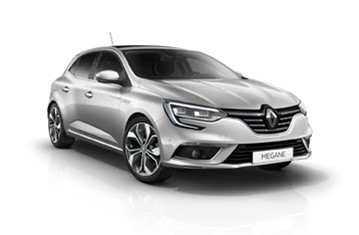
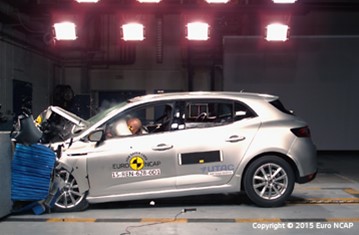

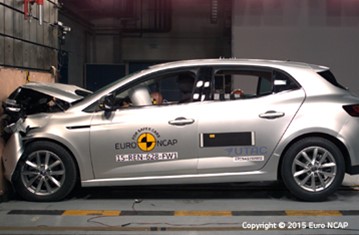

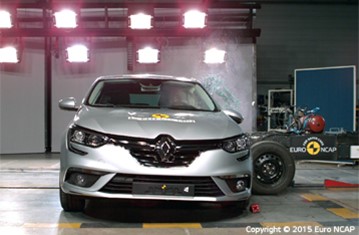
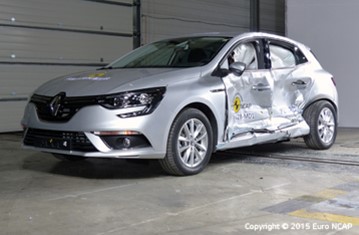

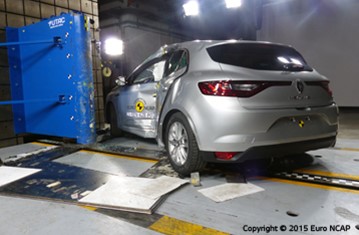



The passenger compartment of the Mégane remained stabled in the frontal impact. Dummy readings indicated good protection of the knees and femurs of the driver and passenger. Renault showed that a similar level of protection would be provided to occupants of different sizes and those sat in different positions. In the side barrier impact, protection was good for all body critical body regions, and the car scored maximum points. In the more severe side pole test, protection of the chest was rated as adequate, with good protection of other parts of the body. In Euro NCAP's tests, the front seats and head restraints demonstrated good protection against whiplash injury in the event of a rear-end collision. A geometric assessment of the rear seats indicated good protection also for occupants of those seats. A low-speed autonomous emergency braking system is not available on the Mégane.